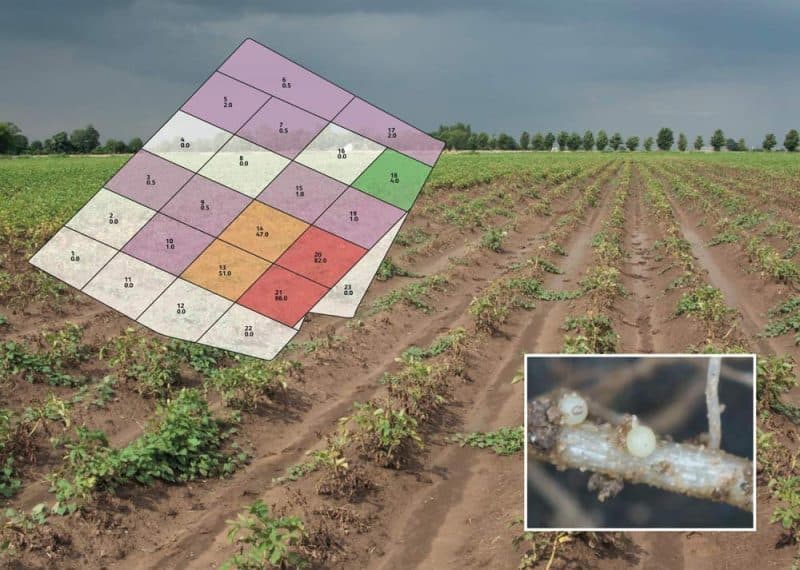Keeping on top of the PCN challenge – Agronomist & Arable Farmer – Richard Watkins
John Swire discovers how one Herefordshire grower is gaining effective control against potato cyst nematode ...
Keeping on top of potato cyst nematode (PCN) populations is an increasing problem for many potato growers, including Herefordshire-based Jonathan Dyke, who runs a mixed potato and arable farm and also finishes Aberdeen Angus beef cattle.
Rotations were previously very tight with potatoes being grown in a rotation of 1:4, which led to PCN occurring in hotspots across fields.
Few growers have the option of growing PCN-resistant varieties, so effective control is key to the operation. Following the advice of his agronomist, Richard Watkins of Hutchinsons, these hotspots can be mapped using the web-based precision agronomy system, Omnia.
Mr Watkins explains: “Using Omnia, we have been able to map the different zones affected by PCN, assigning the relative results for egg numbers to show where they are. This is really important because it has meant we can apply a nematicide on a precision basis to hit the hotspots – so you are not applying it where you do not need to.”
Loss of available nematicides
The industry has seen the loss / restriction of available nematicides over last couple of years, so current nematicide options are Nemathorin (fosthiazate), which has a harvest interval of 119 days and Velum Prime (fluopyram).
With fewer conventional nematicides available, controlling yield-damaging plant parasitic nematode populations has become more challenging.
“At a time of diminishing options for control of PCN through the use of nematicides and the need to demonstrate Stewardship requirements are being met, Omnia is a really useful tool as it has the ability to manage both large and small areas,” he adds. “The ability to map and use precision technology at application will help protect the remaining nematicide actives.”
It also helps keep costs under control; while the nematicides applications improve yield, the average spend on it can be currently nearly double that for late blight protection. This means nematicide application is now the largest single crop protection cost for many potato growers, points out Mr Dyke.
“The end goal of precision applications will be to have a tractor capable of turning applications on or off, but they are not quite there yet,” he says.
Widen the rotation
He agrees with Mr Watkins that for PCN control, reliance is not just on the can, and cultural control methods are also under way, which is why he has looked to widen the rotation by renting fields on a seasonal basis and take some of the pressure off the land. Potatoes are now grown one in six years, with winter wheat, spring oats, and barley also in the rotation.
Renting can bring further challenges though, as the grower may not know the crop history of the field, so Mr Watkins recommends using the Omnia system to detect any PCN hotspots which can then be treated.
“Renting helps widen out rotations, remembering all the details about a field you last touched five years ago can be difficult, and it is so difficult to keep track of paperwork over the time period,” he says.
“This is another situation where Omnia is really helpful, because at the touch of a button you can see all the information from five years – or more – ago all in one place.”
The system also has an option for monitoring pest and disease pressure, and includes the Hutton Criteria*, making it easier to make timely spray decisions because the information is all together.
“With Omnia we can set up virtual local weather stations in fields a long way from the main farm, and growers find it really useful to be able to see the blight pressure in the different places at any time, so they can set spraying priorities.”
Soil health
Soils on Mr Dyke’s farm are mainly Hereford red clay over sandstone, and some of the fields are stony, so over the last four years since Mr Dyke started using Omnia, he has been able to assess soil needs from the detailed soil analysis and appreciate the value of applying manure from the cattle to improve nutrition and soil structure.
“We are also looking into our soil health on the farm with in depth soil health assessments and Omnia provides us with a place to store and interpret these results as well as tracking our actions put into place,” says Mr Dyke.
Omnia generates manure management plans that meet all the legislative requirements for livestock manures, digestate covering field and farm limits, field spreading areas, risk maps and storage requirements.
“It has been a really useful tool to keep us compliant with NVZ rules, demonstrating we are using nematicides responsibly as well as helping us optimise nutrition across the farm,” Mr Dyke adds.
Says Mr Watkins: “By keeping everything in one place, Omnia helps Mr Dyke get the most from his crops, matching plant protection products according to need and ensuring optimum nutrition is applied to the crop and match manure applications with soil requirements.”
* The Hutton Criteria is a method of late blight risk prediction. The conditions for Hutton Criteria occur when there are two consecutive days with a minimum temperature of 10°C, and at least six hours of relative humidity (90%).
